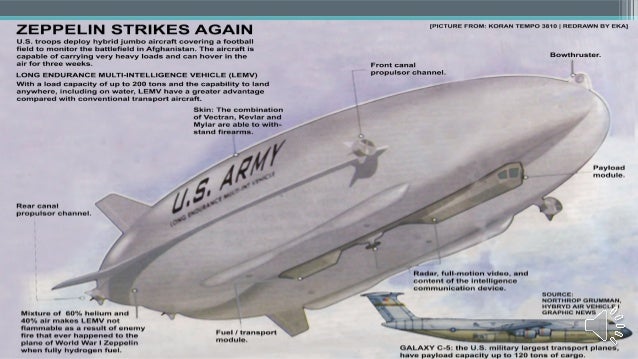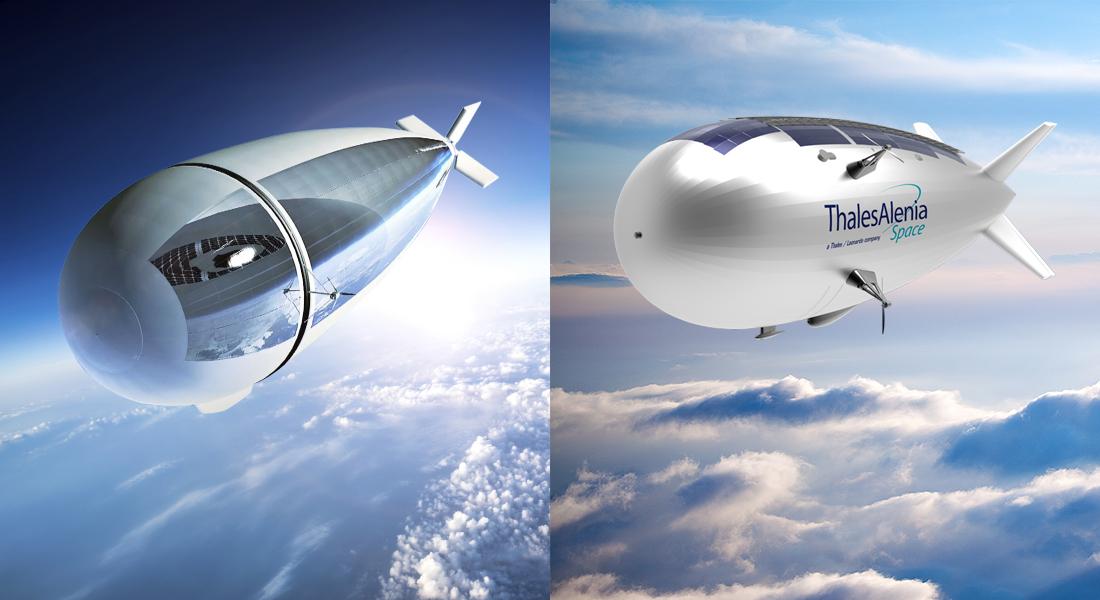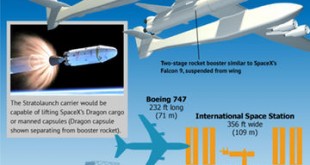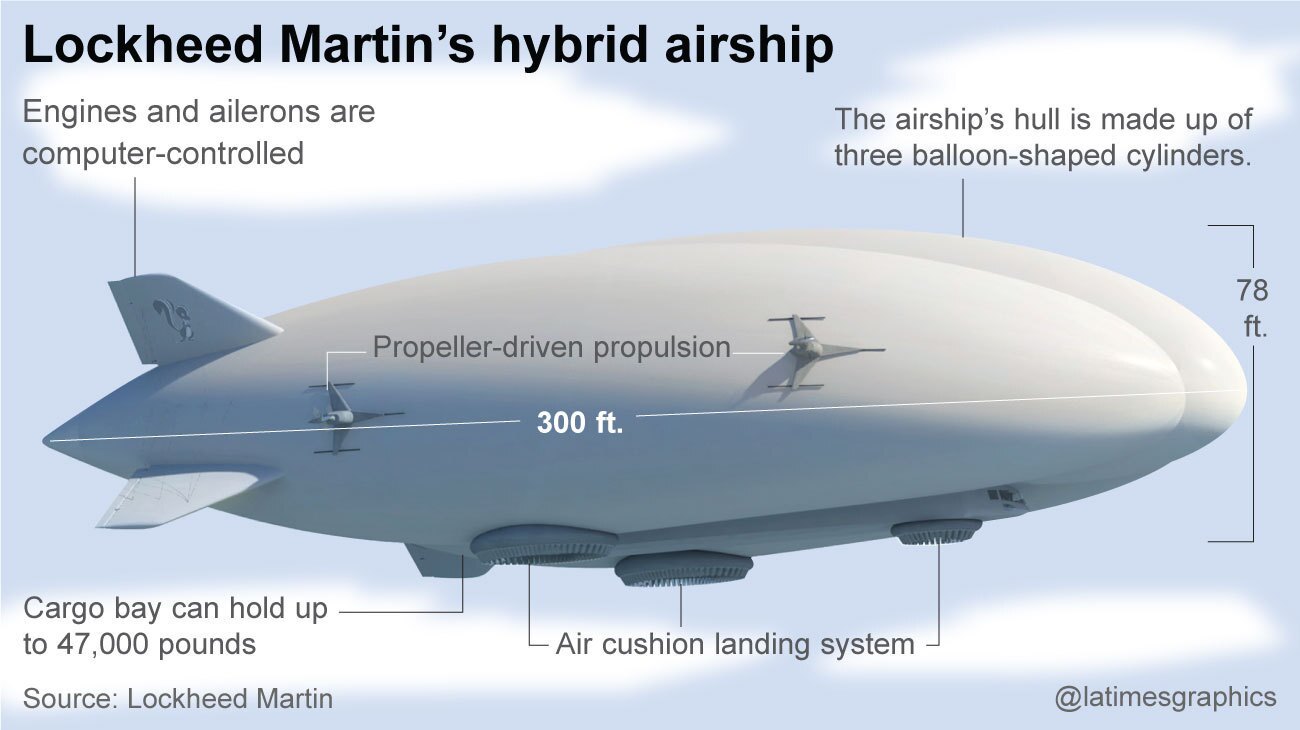Airship is a type of lighter-than-air aircraft which can navigate through the air under its own power. They are different from Aerostats that gain their lift from large gas bags filled with a lifting gas that is less dense than the surrounding air. Historically, airships have been used in applications where the ability to hover in one place for an extended period outweighs the need for speed and maneuverability.
While airships cannot compete with conventional aircraft when it comes to speed, they offer other advantages. First is that with the envelope (that is, the ballon-like structure where the gas goes) providing lift, there is no need to expend fuel to maintain flight. Second is low-speed maneuverability, meaning they don’t require as much infrastructure as airplanes — no runway for instance, or only a short one in the case of hybrids. Third is high potential lifting power — the largest new designs could theoretically carry 500 tons or more, in the same league as the largest cargo planes. Fourth is very high cargo volume — a heavy lift airship would have to be very large, and so would be able to accommodate a correspondingly huge cargo bay.
“They are extremely fuel efficient, which means they are environmentally friendly and have a much lower cost base to operate,” Massey University School of Aviation assistant lecturer Isaac Henderson says. “They also have the luxury of space – you can build a luxurious cabin where people can eat and drink and walk around and, when you are looking at scenery, the slow speed is actually an advantage.”
Applications such as advertising, tourism, camera platforms, geological surveys, and aerial observation are well suited to Airships.
Airships are now making comeback after incorporating enhanced safety technologies. Modern airships have a natural buoyancy and special design that offers a virtually zero catastrophic failure mode. It is estimated there are about 50 of them in existence around the world, in use by private firms as well as the military.
Airlander is designed to use less fuel than a plane, but carry heavier loads than conventional airships. Its developer, Hybrid Air Vehicles, says it can reach 16,000 feet (4,900 meters), travel at up to 90 mph (148 kph) and stay aloft for up to two weeks. “It’s a great British innovation,” said chief executive Stephen McGlennan. “It’s a combination of an aircraft that has parts of normal fixedwing aircraft, it’s got helicopter, it’s got airship.” The company hopes to be building 10 Airlanders a year by 2021.
Airship technology
Airships can be non-rigid, also called blimps, relying on internal pressure to maintain its shape, can be semi-rigid that have some form of supporting structure such as a fixed keel, though still rely on internal pressure for shape and they can also be rigid. Rigid airships have an outer structural framework which maintains the shape and carries all structural loads, while the lifting gas is contained in one or more internal gas bags or cells.
A pan European research team has proposed to reintroduce solar powered airships as a cheap, energy-efficient and environmentally friendly means for mass transportation of people and goods. It is predicted that by 2020 the number of aircraft passengers will reach 400 million. The movement of freight by air is expected to increase by more than 340 per cent over the next 20 years and airships can play important part complementing the commercial aviation.
The Multibody Advanced Airship for Transport (MAAT) project envisages the design of a cruiser which can travel across the globe on a set route. Smaller feeder ships carrying people and goods would then be able to dock onto the cruiser while it is still moving.
Recently NASA has proposed a High Altitude Venus Operational Concept (Havoc) vehicle, a helium-filled, solar-powered airship that will be doing the atmospheric exploring of Venus. The robotic version would be 31 meters long (about half the size of the Goodyear blimp), while the crewed version would be nearly 130 meters long, or twice the size of a Boeing 747. The top of the airship would be covered with more than 1,000 square meters of solar panels, with a gondola slung underneath for instruments and, in the crewed version, a small habitat and the ascent vehicle that the astronauts would use to return to Venus’s orbit, and home.

In 2016, Lockheed Martin Corp. won a nearly $500 million order for as many as a dozen of its hybrid-electric LMH-1 airships (operational in 2020 or 2021) from a buyer who plans to lease their 20-tons of freight capacity to Arctic oil and gas companies. Leasing an airship is cheaper than building new roads across permafrost melting due to climate change, and roughly seven times cheaper per ton than using heavy-lift helicopters. As China and the rest of the world extend their search for raw materials into ever-more remote regions, airships are likely to become crucial links in logistics chains.
Airships aren’t perfect, of course. The biggest one by far is drag which makes them slower than airplanes and helicopters (though faster than cargo ships). With drag increasing with the square of velocity, the amount of power required to move an airship will quickly eat into its efficiency advantage from floating — even at highway speeds (Germany’s famous Graf Zeppelin had a top speed of 128 mph, but generally cruised at about 70 when it traversed the globe in the 1920s and ’30s). Their immense size leaves them much more exposed to winds and adverse weather than traditional planes though that should be less of an issue with modern weather prediction. Helium, the preferred gas for the new generation of airships, is much safer than the hydrogen that burned up the Hindenburg but also substantially more expensive.
H3 Dynamics Adds Hydrogen-Electric Propulsion to Unmanned Airships Built in France by HyLight
H3 Dynamics and HyLight have joined forces to bring new long range, sustainable and quiet unmanned airships to a range of commercial applications. Traditionally, airships use combustion engines for their propulsion power. With new hydrogen propulsion system developments at H3 Dynamics, HyLight’s new breed of airships will now offer long-range zero emission flight and open a whole new category in air mobility. The two companies share a common goal, to decarbonize the aerial industry.
HyLight’s unmanned airships move slowly but don’t need to consume any power to stay aloft. They can operate for days at a time with heavier payloads compared to conventional drones, to conduct long range inspection of critical energy assets like power-lines & pipelines or scan industrial infrastructure over long distances. Airships could also hover around specific areas to provide critical connectivity for large scale industrial sites – or provide vital communications after a natural disaster.
HyLight wants to decarbonize the aerial data industry by providing long-range aerial data collection and analysis services using its unmanned airship systems for the inspection of power lines, pipelines, and railways. Its airship come with hydrogen electric propulsion making them sustainable, silent, efficient, and long-range to cover large areas or distances. The company was started in France and has recently demonstrated the first flight of its hydrogen-electric platform.
Military Applications
The use of aerostats or “lighter than air” aircraft for military purposes has been around since the invention of the hot air balloon by the brothers Mongolfier.
Airships are also useful to Military in multiple roles. They can act as command, control and communication platform to establish and maintain reliable and secure connectivity among all forces providing transparent data across the echelons They can precisely locate friendly and enemy forces, detect targets on an extended battlefield at a minimal exposure to enemy forces. They can provide real time targeting, navigation assistance, battle management; monitor radio conversations, etc.
In the 1930s, the US Navy commissioned two Akron-class airships. They are 785 feet in length and could go up to a speed of 72 knots carrying 89 crew members, four aircraft, and seven machine guns. The intended use of the airships was to act as “eyes for the fleet,” and achieved moderate success. However, in 1933, the Akron crashed killing 73 crew members including Rear Adm. William A. Moffett, the Chief of the Bureau of Aeronautics. Then-President Franklin D. Roosevelt called the accident a “national disaster”. Two years later, the sister ship Macon crashed killing two people on board and with that, the era of airships ended. Airships were sidelined after the series of crashes like R101 crash in France in 1930 that killed 48, and, seven years later, when the German airship caught fire and killed 36 people.
Proceedings, the journal of the US Naval Institute, first deliberated on this, saying the airships have the potential to “transform military logistics, command-and-control, and surveillance and reconnaissance”.
Now with modern technology, the article argued that attack airships would not replace traditional surface warships but instead augment them, providing a new layer of distributed lethality to the fleet and support for Marines and soldiers on the ground. “Airships can screen large swathes of the ocean where enemy contact is unlikely but some friendly sensor presence — backed up by weapons — would be useful. Convoys would gain access to improved situational awareness as well as an airborne antisubmarine warfare capability,” it said.
The journal concluded that the airship if developed today without the funding issues, could carry a battery of several dozen unmanned aerial vehicles, each equipped with radar, electro-optical, and other sensors, to extend the sensor reach the mothership and hence the surface fleet. It could also be equipped with a variety of weapons for use against ships, submarines, lower-performance aircraft such as helicopters, and targets on land. “The aircraft carrier’s future seems fairly secure, but tomorrow’s fleet almost certainly will sail alongside other platforms that project air power in new and innovative ways.”
China plan to build assembly line for Airships
China Aviation Industry General Aircraft Co., Ltd. (CAIGA) recently announced they’re planning to build an airship assembly line. Production should start in 2022 and could result in dozens of the giant ships — each twice as long as a Boeing Co. 747 — floating around the world.
Due to advancements in technologies including hybrid-electric power, Airships are poised to offer a cheap, potentially low-carbon means of delivering cargo to and from regions of the world that lack basic infrastructure, including airstrips. They can provide economic assistance, as well as investment through its signature Belt and Road Initiative, to regions that lack infrastructure for planes or even trucks. In the developing regions of Africa and Asia that are China’s primary targets, less than half of the population has access to good roads (lack of transportation access correlates with poverty). Flying Whales claims that the LCA60T will carry parts and machinery, including — potentially — wind-turbine blades (heavy-lift airships will have immense cargo holds). Generators, batteries, solar panels and even prefab buildings (China is a global leader in the prefab industry) could also catch rides. The delivery of post-disaster humanitarian assistance to remote areas — an area in which China has become a major player — would also benefit from airship transport.
They also promise to reduce greenhouse gas emissions. As far back as 2010, the International Air Transportation Association called for the global air freight industry to shift from heavy freighters to lightweight airships to reach emission targets. According to the group, airships produce 80-90 percent fewer emissions and, because they fly at low altitudes, don’t produce heat trapping-contrails. China’s air freight market is one of the world’s biggest and fastest-growing; even a small shift toward airships would make difference in slowing the sector’s emissions growth.
China’s Yuanmeng
The Chinese Academy of Sciences development plan for the 13th Five-Year Plan period (2016-2020) listed 140 research and development priorities, among which were tasks to develop key
technologies and techniques for controllable stratospheric airships and conduct flight tests before the end of 2020.
To meet these goals, the stratospheric airship Yuanmeng (Dream) was jointly developed by
Beijing Aerospace Technology Company and Beijing University of Astronautics and Aeronautics (BeiHang). High strength materials for the airship were developed by Beijing University.
The airship’s missions include:
• Wide-band communication, including serving as a military communications platform in the event of a loss in satellite communications.
• High-definition observation, including environmental monitoring and detection of military threats such as stealth aircraft, cruise missiles, and warships from several hundred miles away.
• Space imaging, including stereo imagery of objects in orbit.
China began testing on a new type of helium stratospheric airship in October 2015, The Yuanmeng (which means “dream”) was launched from Xilinhot in Inner Mongolia to test its systems and capabilities. According to reports, the 75-metre-long airship’s 48-hour test flight last week saw the airship rise to a near-space altitude of 20 kilometres. The Yuanmeng aircraft can reach a height of 100 kilometers and conduct reconnaissance without being seen by other aircraft or rockets. The ship will operate at altitudes inaccessible to the majority of air defense systems.

Basic characteristics of this airship are listed below:
• Length: 75 m (246 ft)
• Diameter: 22 m (72 ft)
• Volume: 18,000 cubic meters (635,664 cubic feet)
• Operating altitude: 20 km (12.4 miles, 65,600 ft)
• Payload (mission equipment): 300 kg (660 pounds)
• Power source: Photovoltaic cells on the hull for power during the day and battery or fuel cell for power at night
• Propulsion: 2 x large diameter electric motor driven propellers mounted on the nose and tail of the airship and 4 x small maneuvering propulsors along the flanks for the airship
• Mission duration: 6 months
The airship is filled with 18 thousand cubic meters of helium, stands at 22 metres high, can carry a payload of between 4.5 and 6.3 metric tonnes. The airship is said to be able to fly for up to six months at a stretch, with a large array of solar panels covering the mid-portion of the aircraft’s top side that can generate electricity for the motors. Solar energy is ideal for high-altitude drones and balloons, as they significantly reduce the need for fuel. Reconnaissance and communications equipment are located inside the gondola.
People’s Daily suggests that it might be used for communications purposes, as the ship is said to be loaded with systems for wideband communication, data relay, high-definition observation, and spatial imaging. “Yuan Meng may become the pinnacle of the military food chain, soaring high above the South China Sea in search of aircraft. Together with the information collected by satellites, aircraft, submarines and drones, Yuanmeng will allow the People’s Liberation Army of China to get a full picture of maritime hostilities,” People’s Daily Online experts noted in publication.
The Yuanmeng program may be the start of China developing a wider portfolio of large airships. China Aviation Industry General Aircraft Co. Ltd. (CAIGA), a subsidiary of China Aviation Industry Group, has partnered with French firm Flying Whales to build heavy airships, with a 60-ton payload cargo airship reported to be their first aircraft.
Hybrid Air Vehicle’s Airlander
The UK-conceived and developed Airlander 10 is scheduled to complete certification in late 2024 and enter commercial service in 2026. The ‘hybrid air vehicle’ – the company developing it shares that name – will initially be used for tourist flights, but Spanish regional airline Air Nostrum has reserved ten examples of the Airlander 10 to use as commercial airliners for up to 100 passengers.
The later, larger, Airlander 50, which Hybrid Air Vehicles (HAV) aims to have in service by the early 2030s, will be a freighter, as will a French rival being developed by Flying Whales.
A blimp shaped, helium filled airship Airlander considered the world’s largest aircraft had its first test flight from the airfield on 17 August 2016. However, it suffered a damage during its second flight after nosediving on landing during its second test flight. In a statement, Hybrid Air Vehicles (HAV), said: “The Airlander experienced a heavy landing and the front of the flight deck has sustained some damage which is currently being assessed.”
HAV is developing Airlander 10 as the first system, which has small cargo lift and passenger capacity and will eventually be followed by the Airlander 50 – a heavy-lift platform. Airlander 10 can carry up to 10 metric tons (22,050 pounds) of passengers or cargo while Airlander 50 capable of carrying 50 metric tons (110,000 pounds), in service by the early 2020s. It adds that because the payload capacity of hybrid airships is so large, many sensor developers in the UK are keen to integrate their systems on the Airlander, and are therefore putting pressure on the government to invest in the capability.
HAV CEO Tom Grundy believes that the Airlander 10 is an idea whose time has come. Also different from traditional airships is that Airlander lands on large ‘skids’ below the envelope. Traditionally, airships have tied up to a mooring mast above the ground; being able to load and unload passengers and cargo at ground level makes this a much easier process.
Airlander is currently powered by four combustion engines. Even these produce 75% fewer emissions than an equivalent aircraft, but HAV plans to replace the first two, then all, of the engines with electric motors in coming years, cutting emissions to zero.
Grundy describes the aircraft as “production-ready” and advanced discussions are under way with local authorities in South Yorkshire to build a factory there. He sees Airlander 10 as having three main roles: passenger transport, freighter and, in military service, surveillance.
Hybrid Air Vehicles Ltd. signed a memorandum of understanding in London with Vertex Aerospace LLC to deliver missionized Airlander 10 aircraft to the U.S. Department of Defense (DoD). The two organizations will partner together to provide joint proposals to the DoD for fully configured Airlander 10 aircraft. The Hybrid Air Vehicles HAV 304/Airlander 10 is a hybrid airship designed and built by British manufacturer Hybrid Air Vehicles (HAV). Comprising a helium airship with auxiliary wing and tail surfaces, it flies using both aerostatic and aerodynamic lift and is powered by four diesel engine-driven ducted propellers.
The design of the aircraft makes it rather stealthy, so is suited for military applications. The curve of the airframe provides a low silhouette, while a low infrared signature as a result of low engine use protects it against heat-seeking missiles. It also has a low radar signature because it uses mainly composites instead of metal, and travels slowly and quietly, therefore is visually and audibly stealthy. “This genuinely solves a military ISR problem,” the company says. “There is increasingly a need to watch the bad people all the time – this will be a crucial discriminator.”
A-NSE, a French company, manufactures and operates airships and aerostats. A-NSE has been testing its airships for the French Army for last two years. Airships and aerostats are operated to provide intelligence, surveillance, and reconnaissance (ISR) support. Many innovations are developed by A- NSE: water ballast take-off and landing system, variable geometry envelope, thrust–vectoring system etc….
Lockheed Martin Readies LMH-1 Hybrid Airship Assembly
Lockheed Martin and Hybrid Enterprises are developing commercial hybrid airship LMH1 that would able to carry up to 19 passengers, hoist 20 tons of supplies, equipment and can even land on water. The The first flight of 280-ft.-long LMH-1 is targeted for mid-2017 and is expected to enter service in 2018.
The LMH1 also holds great promise for disaster relief efforts, as it would be able to deliver aid supplies on a large scale to rural, difficult-to-reach communities that are often stranded after natural disasters, particularly in developing nations.
Northrop Grumman’s Long Endurance Multi-Intelligence Vehicle (LEMV)
Northrop Grumman is developing the Long Endurance Multi-Intelligence Vehicle (LEMV), a long-range hybrid airship, capable of providing intelligence, surveillance and reconnaissance support for land forces, for the US Army. Northrop Grumman has teamed-up with Hybrid Air Vehicles (HAV), Warwick Mills, ILC Dover, AAI Corporation and SAIC for the LEMV development. HAV provides the base platform, while Northrop Grumman is responsible for system integration, flight and ground control systems.
LEMV has a length of 91m, width of 34m and a height of 26m. The hull of LEMV will be made of laminated fabric. The envelope volume of the air vehicle is 38,000m³. The vehicle can carry multi-intelligence payloads, such as sensors, ground moving target indicator radar, full motion video, signal intelligence and communications relay systems. The aerodynamic shape of the hull delivers up to 40% of lifting for the vehicle.

LEMV can be optionally manned, remotely piloted or autonomously operated. It can fly at a maximum altitude of 20,000ft. It is capable of carrying payload weight of 2,750lbs. It consumes about 3,500 gallons of fuel to remain aloft continuously for a period of 21 days. The maximum range of the air vehicle is 2,400nm with 15,000lbs (heavy lift configuration). The vehicle can fly at a speed of 30kt and a dash speed of 80kt.
LEMV is powered by four 350hp 4l V8 direct injection diesel engines, two forward of the hull and two aft of the hull. Equipped with supercharged induction system, each engine is assembled in ducts with blown vanes. The configuration allows thrust vectoring for optimum control on the motion of the air vehicle.
Russia’s Atlant
Augur RoseAercoSystems is developing hi-tech 130-metre-long military airship called Atlant, which will be capable of taking off and landing without a runway, carrying 200 military personnel or as much as 60 tonnes of cargo at speeds of up to 86mph. They shall be able to withstand temperatures up to -40 Celsius, typical in Russian winters.
There will also be a smaller, swifter version, which can carry up to 16 tonnes at 105mph. The airship industry is slowing making a comeback, almost seven decades after the German Hindenburg disaster that left 35 people dead. It is estimated there are about 50 of them in existence around the world, in use by private firms as well as the military.
These high tech ships shall be created merging the technology from planes, hovercraft and airships, utilize different principles of flight control, special balancing system and equipped with sophisticated high-precision computer technology. Body will consist of hard shell made of composites. During the unloading of the weight at the point of arrival, for instance, the airship will be able to get heavier via controls without needing ballast. In that way it will not get weightless after unloading and will not soar into the stratosphere.
Manufacturers insist that they are cheaper to fly than helicopters and airplanes, can carry more cargo and are capable of reaching remote and hard-to-reach areas. The Atlant will cost 30 per cent less than Russia’s Mi-26 heavy transport helicopter, which can cost up to $25million.
There is speculation the Russian military aims to use the blimp at border points, such as to control drug trafficking. However, it can also be used to move mass numbers of personnel around the country, or into combat zones, more efficiently.
The manufacturers say there is also interest from within the oil and gas industry in Siberia and the Arctic, particularly with the current costs and difficulty of building infrastructure and moving equipment. Mass cargo transportation is another possible use for the new airship, and there are hopes that the Atlant could become a cheap method of moving people around Siberia.
French military taps Thales to study ISR sensor options for ‘Stratobus’ airship
Thales Alenia Space and Thales signed a contract this week with the DGA, France’s defense procurement agency, to study if intelligence, surveillance and reconnaissance sensors could work from an airship. The aim of the project is to see if stratospheric platforms of this type, operating from an altitude of 20 kilometers (65,600 feet), where the winds are moderate and the air density sufficient to carry them, could be useful to the French armed forces. The companies have been asked to design an operational concept study for an ISR mission, including exercises simulating its use in theaters of operation. The contract, whose value was not disclosed, also calls for a full-scale demonstrator to be built capable of flying in the stratosphere to demonstrate how an ISR mission of this type would perform.

Thales Alenia Space (held 67 percent by Thales and 33 percent by Leonardo) launched development of the 100 meters (328 feet) long “Stratobus” airship in April 2016. Powered only by solar energy and measuring 33 meters (108 feet) across, the balloon would rise on its own to its final altitude, with no need for a launcher. To maintain its position and to withstand winds of up to 90 kph (56 mph), Stratobus would have four electric motors operating 24/7, which are controlled by GPS to keep the vehicle permanently in line with a reference point at ground level.
The energy would be broken down into dihydrogen and gaseous oxygen stored separately in tanks placed in the nacelle. At night, the two gases would be recombined, providing water and electricity to power the balloon. The Stratobus would significantly increase the area monitored by a single platform, as the high altitude puts the horizon at 500 kilometers (310 miles). Considered a hybrid between a drone and a satellite, it would be able to linger for up to a year over a given area after which time it would have to be grounded for maintenance. During these maintenance periods a second airship would ensure mission continuity.It is expected that each Stratobus would last five years.
References and Resources also include:
https://www.aerosociety.com/news/airship-resurgence/
https://lynceans.org/wp-content/uploads/2021/04/China-Yuanmeng-stratospheric-airship-converted.pdf
 International Defense Security & Technology Your trusted Source for News, Research and Analysis
International Defense Security & Technology Your trusted Source for News, Research and Analysis



